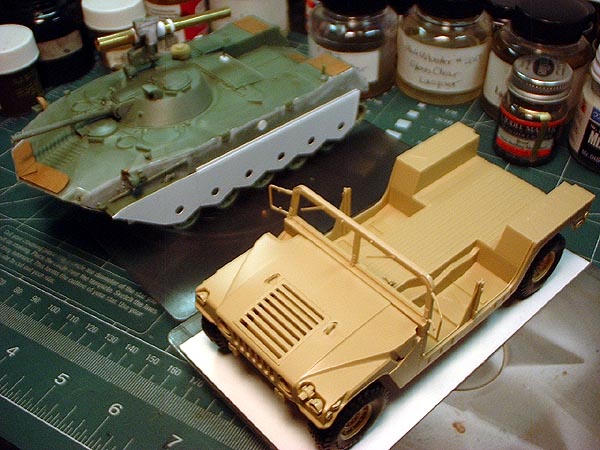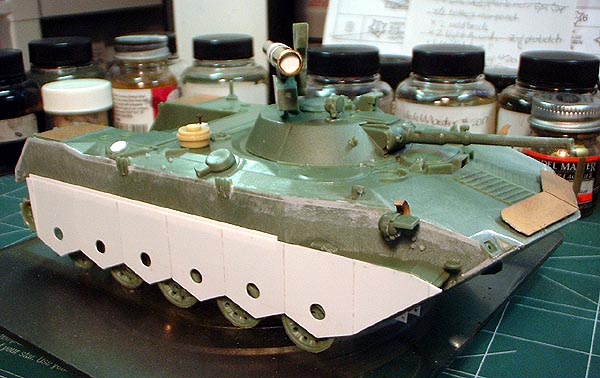|
Skif Model Kit #223 comes
cast in olive green plastic. It is soft, but
not brittle. The casting is well-done, with
light flashing in some minor places in my
example - none to complain about. Ejector
pin marring is minor and easily removable
due to the softness of the plastic. The kit
comes with individual track links - four
sprues of 48 links. You'll have 18 extra
links, in case some are launched into
oblivion. There is a photoetched fret with
grills, splash vanes, and light guards. I
thought them a bit thick until I used them -
they're fine, if not crude-looking. Other
than that, you'll get two extra Road Wheels,
one extra Suspension Arm for each side, and
two extra Return Roller Wheels. There are no
figures provided in the kit, and you get the
basic OVM Equipment for the exterior.
The Hull comes in five
pieces to make up the Lower portion - with a
single-piece Upper Hull. I was skeptical
about joining them without warpage - but
this proved to be a breeze. Later problems
came in mating the upper and lower Hull
parts, though. A lot of filler and sanding
came next - more than I expected.
There is a token Interior
provided by Skif. Drawback here is that I
have no idea what the real BMD-1P interior
looks like and the Instruction Sheet really
doesn't shed anymore light there. The
Spartan interior doesn't convey the sense of
crampness that the real vehicle likely does.

Posed with Tamiya's M1025
HMMWV, the small size of the BMD AIFV
becomes apparent. It is darned near "cute".
I can easily see this loaded onto a C-130
Aircraft - but I can't see a Squad of
Solders or Marines crammed inside.
With the Skif kit, you
don't get much. Perhaps that's because there
isn't a whole lot to the BMD-1. I don't
know. So, not wanting to stray too far away
from the basic design fielded, I only opted
for minor additions that might be plausible
for one in service during WW III. My setting
was the Soviet Invasion of Alaska - and
seizure of the US Alaskan Oil Fields.
Spearheads of the Soviet forces would be
airborne elite troops in little vehicles
like this one.
The biggest visual addition
came in the form of a soft armor addition in
rubberized, flexible, skirts for the flanks
of the vehicle. They would add a little more
protection to the Road Wheels and Track
Runs, and not a lot of weight like armor
plating. They could double as dampers for IR
sensors locking on the hot Drive Sprocket
and Tracks/Road Wheels.
Trimming them out to sheet
styrene, I dragon-teethed the bottom edges
for interest, and punched holes in each
skirt intended as a step aid for troops
ingressing the BMD-1. I made up a mounting
frame out of styrene strip and added punched
disc bolts heads.
Small Antenna, Armored Caps
for ports, and small detail items came from
the spares box - in sparing amounts. The
BMD-1 is already interesting in its own
right - no need to clutter it up beyond
recognition.
The Anti-Tank Weapon
Station in my Skif model kit was pretty
useless - so I dressed it up with brass
tubing and some minor details to give an
impression of functionality without fanfare
- typical Soviet of that era. I added a
firing-ready round in the Launcher, making
it appear much too powerful for the little
carrier.
The biggest drawback in the
kit, for me, was the tracks. I contemplated
replacing them, but at that time they were
prohibitively expensive - especially for a
model I was just goofing around with. I
opted out of replacing them and worked with
what I had.
Lastly, my Soviet Invasion
Force would bear no insignia or markings on
their vehicles - so none on my BMD-1P+
Wolverine. I contemplated a more elaborate
camouflage scheme for it, but it really
didn't fit how I imagined the real one would
look. So I weathered it up instead. A real
scrapper.

|